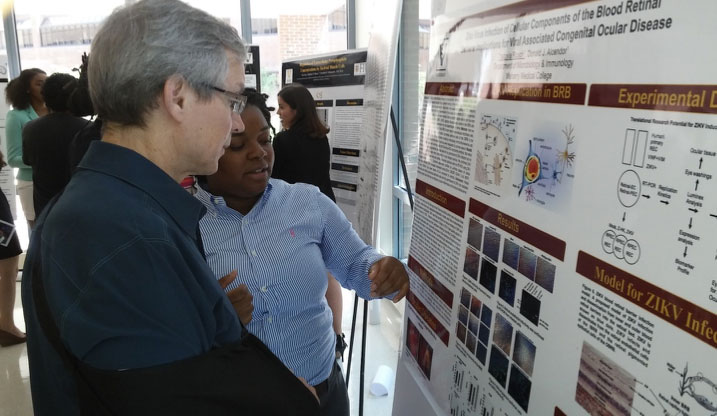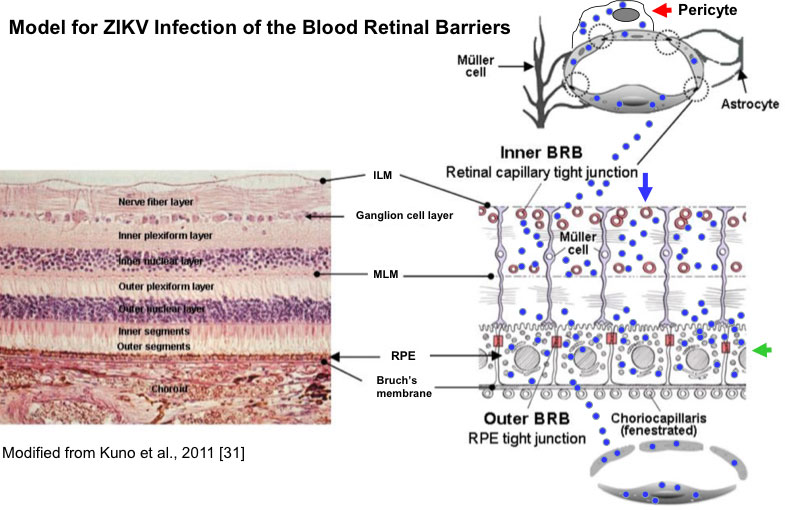Home » News » Zika Virus Infection and Ocular Disease in Children
Zika Virus Infection and Ocular Disease in Children
Posted by anderc8 on Thursday, March 9, 2017 in News, TIPs 2015.
Written by Donald J. Alcendor, Associate Professor at Meharry Medical College, Associate Adjunct Professor, in the Department of Cancer Biology at Vanderbilt (research in the Alcendor lab at Meharry, which is affiliated with the Pre3 Initiative)
The Zika virus belongs to the Flavirvirus family of viruses that is spreading on a global scale. Outbreaks in Brazil in 2015 quickly spread to more than 70 countries in the Americas and the Caribbean. Currently there is no specific treatment or vaccine for Zika virus infection. This represents an urgent, unmet medical need for effective and safe therapies against ZIKV. The estimated number of pregnant women with ZIKV infection is increasing daily, and the future impact on health care systems around the world will be significant.
Zika virus infection is associated with an increase in the incidence of Guillain-Barré syndrome, a condition where the immune system attacks the nervous system. ZIKV infection also causes developmental problems in newborn babies that includes microcephaly or “smaller head size.” Unlike adults infected with ZIKV, babies infected in the womb with ZIKV who develop microcephaly have severe eye disease. A major focus in the Alcendor lab at Meharry is to better understand how ZIKV invades the eye and to identify the different cells in the eye that are infected by the virus. The ultimate goal of the research, which is strongly supported by the TIPs program at Vanderbilt, is to develop a treatment for ZIKV eye disease in the form of an eye drop that can administered to both babies and adults. This drug formulation would also be examined to treat systemic ZIKV disease.
Understanding the complexities involved in ZIKV associated eye disease and the subsequent development of a treatment for the eye could prove effective for systemic therapies that would prevent pregnant women from passing this infection to their unborn children.
The Vanderbilt Pre3 Initiative (Preventing adverse Pregnancy outcomes and Prematurity) fosters structured collaborative opportunities to engage a multitude of scientific investigators on and off the Vanderbilt campus. The initiative, directed by Dr. David Aronoff, Division Chief for the Department Infectious Disease at Vanderbilt, has been inclusive of investigators from both large and small research programs. The Pre3 Initiative has greatly contributed to the Alcendor laboratory at Meharry in developing an infection model for ZIKV eye disease in a petri dish.

VSSA student Tracovia Roach and Dr. William Valentine, Director, Summer Short Term Training Program, at the 2016 VSSA Poser Session.
In the Alcendor lab at Meharry, summer student Tracoyia Roach from Florida A&M University is being mentored as a member of the Vanderbilt Summer Science Academy interns that come to Vanderbilt in the summer for eight weeks to gain research experience with established research investigators at Vanderbilt and Meharry. The work performed by Ms. Roach and Dr. Alcendor on ZIKV infection of cells the human eye have resulted in a published scientific paper in the Journal of Neuroinflammation. As part of the program, students are asked to present their research findings in a poster symposium at Vanderbilt (Figure 1). Ms. Roach will be a graduate student in Interdisciplinary Biomedical Sciences program at the University of Florida’s College of Medicine beginning in the fall of 2017.
The research project performed by Ms. Roach and Dr. Alcendor was designed to identify cells in the human eye for ZIKV infection and to identify specific inflammation protein known as cytokines that are produced by these cells during their exposure to ZIKV. Our studies show that retinal endothelial cells and retinal pericytes and retinal pigmented epithelial cells (not shown) are the main cell types in the eye that are infected by ZIKV (as shown in the figure below).

We used this information to develop a model for how ZIKV invades the eye of infected person. In the hypothetical model, we propose that ZIKV enters the blood steam by way of arterial system and spread into the retina (blue dots) of the eye and causes inflammation that can lead to more serious disease.

Future directions for these studies will include the testing of a ZIKV antiviral reagent that was developed by Drs. Alcendor, Waldemar Popik and Atanu Khatua at Meharry as a treatment and prevention strategy for ZIKV infection. This drug is shown to prevent ZIKV infection in pretreated cells in petri dish by more than 99 percent over an extended period of time and will inhibit ZIKV induced inflammation. The antiviral reagent is now being employed in preclinical studies. The ZIKV projects in the Alcendor lab at Meharry was initially developed by supported of Meharry President, Dr. James E.K. Hildreth, Zika virus Research Startup Award.
We encourage comments and suggestions and we welcome the opportunity for those interested to learn more about eye disease in babies with congenital ZIKV syndrome. You can contact the Alcendor lab at Meharry (dalcendor@mmc.edu) for additional information.
